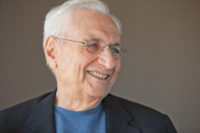Gehry may be the first prominent architect to take steps towards labor reform on Saadiyat Island, the luxury arts and real estate development 500 meters off the shore of Abu Dhabi where the Guggenheim, after years of delays, is expected to soon begin construction. The museum will join Rafael Viñoly’s New York University Abu Dhabi (completed this year), Norman Foster’s Zayed National Museum (opening in 2016), and Jean Nouvel’s Louvre satellite, expected to open next year. Tadao Ando and Zaha Hadid have also designed buildings for future development phases.
Focus on labor issues surrounding Persian Gulf-area projects sharpened this spring after Hadid, at a press conference reported by the Guardian, said that as an architect she has nothing to do with the workers, but that the local government should take responsibility for problems with labor conditions. (On August 21, Hadid filed a lawsuit in New York County Supreme Court against critic Martin Filler and the New York Review of Books for errors in an article about conditions on the site of her Al Wakrah soccer stadium in Qatar, which had yet to begin construction.) “I don’t have the power to make these changes,” Hadid told the Architects' Journal in an interview published last week. “But maybe I am wrong and I could help. But I don’t know how.”
Gehry’s plan could be a template for architects who feel similarly unsure how to help. “What is the proper role for the architect? That’s the fundamental question,” Scott Horton, Gehry’s lawyer, said in an interview with Architectural Record. “It’s not a legal responsibility, but it’s a moral responsibility.”
For Gehry, the conversation about worker conditions began at the start of his involvement with the Guggenheim Abu Dhabi. After Human Rights Watch painted a grim portrait of worker conditions on Saadiyat Island in a report in 2009, Gehry approached Horton—an expert in human rights law—to give him advice in connection with the project. Before contracts were finalized with the state development agency, TDIC, Gehry raised concerns informed by that report and those of other groups on workers’ conditions.
While Abu Dhabi already has a comprehensive labor code, it is feebly enforced. By working directly with the Abu Dhabi authorities, Horton reasons, the law and policies can be implemented and worker conditions improved.
Horton and Gehry have targeted five primary concerns: the prioritization of worker health and safety, the accessibility to passports and other documents typically retained by employers to prevent laborers from leaving the country, the appointment of a law-abiding and accountable general contractor, the establishment of an independent site monitor, and the abolition or reimbursement of steep recruitment fees associated with the kafala system—the worker sponsorship approach prevalent in the Gulf region.
Gehry urged the Guggenheim to issue a joint statement with the TDIC, outlining these measures, which has been on the museum’s website since 2010. Human Rights Watch and activists said their statement was not enough. In a similar situation in February 2010, New York University had issued a statement of the institution’s commitment to proper working conditions on its new Abu Dhabi campus, but according to a New York Times investigation of the construction site this year, it was not enforced. In late June, the university appointed an international investigator to review the allegations.
Gehry’s lawyer says they are working in tandem with Abu Dhabi officials to generate changes, which they hope will soon become a reality. To alleviate squalid living conditions, Gehry and Horton are encouraging building additional housing. TDIC has already built a village for some construction workers, but it is not enough to house the rapid influx of migrant workers with the resumption of the Guggenheim project, set to open in 2017. To offset the steep fees charged by foreign recruiters—often more than three times a worker’s annual income—they propose that the contractor reimburse the worker to cover the cost. TDIC appointed PricewaterhouseCoopers as an outside monitor, which has issued quarterly reports for the last two years. Contracting bids were submitted in late August and TDIC is now on the cusp of hiring a general contractor, a pivotal component to fair worker treatment.
Horton acknowledges the challenges of accomplishing such goals. “It’s going to be a process that will go to the end of the project,” he said. “We are optimistic that, as an approach, this makes sense and is likely to improve the position of workers on our project.”
By engaging with these issues Horton believes the Guggenheim project has the potential to influence the treatment of workers on other sites: “This could serve as a model for doing things right.”








Post a comment to this article
Report Abusive Comment